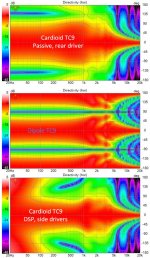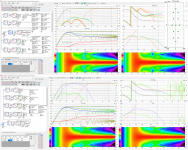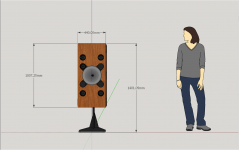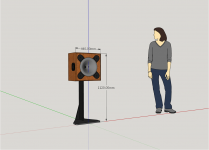just read the whole OB gallery thread starting from Bush's first OB post. hope you are right that CD +ambience is equal. Key for me was need for those speakers to be on casters so can be pulled out into room for listening. I can't do that.
What are your thoughts on ambience drivers now it terms of frequency range, position, directionality, and aiming. I read what you linked in your thread; also looked at Duke LeJeune late ceiling splash and recall BWaslo's much lower key approach.
What are your thoughts on ambience drivers now it terms of frequency range, position, directionality, and aiming. I read what you linked in your thread; also looked at Duke LeJeune late ceiling splash and recall BWaslo's much lower key approach.
For starters: I won't guarantee anything 🙂. I was in a similar position, as there was no way to pull out speakers from the wall. The first thing I looked at was OB, until I realized how much room it would take/need.
The key to succesfull ambient speakers is decorrelation. I wouldn't want to use them without them diffracting/reflecting off of their environment. I'm trying to mimic a "better space" after all. In hindsight I would have loved if they could play down a little lower in frequency, even though that brings problems of it's own in practice.
BWaslo's ambient parts play way higher than mine, and come from a different angle/direction. I opted for the sound arriving from lateral angles based on the research I had done at the time.
Read a couple of Griesinger papers, there are plenty available that are worth the time to read (in my opinion).
As said, I cannot guarantee anything, but if this works out succesfully for you, you'd have complete controll over it. That might have been a key factor for me, as I've experimented with lots of combinations and will probably test a few more 😀.
The key to succesfull ambient speakers is decorrelation. I wouldn't want to use them without them diffracting/reflecting off of their environment. I'm trying to mimic a "better space" after all. In hindsight I would have loved if they could play down a little lower in frequency, even though that brings problems of it's own in practice.
BWaslo's ambient parts play way higher than mine, and come from a different angle/direction. I opted for the sound arriving from lateral angles based on the research I had done at the time.
Read a couple of Griesinger papers, there are plenty available that are worth the time to read (in my opinion).
As said, I cannot guarantee anything, but if this works out succesfully for you, you'd have complete controll over it. That might have been a key factor for me, as I've experimented with lots of combinations and will probably test a few more 😀.
It just occurred to me that I already have side, top, and bottom speakers for cardioid. The drivers are good up to almost 5khz. I could add in a second delayed DSP channel for some or all of these drivers to provide ambience. what do you think?
Worth a try/shot. No harm there.
As far as enhancing the space goes, my preference lies in the ambience arriving from lateral angles. Also based on the cross-talk inherent in Stereo etc.
As far as enhancing the space goes, my preference lies in the ambience arriving from lateral angles. Also based on the cross-talk inherent in Stereo etc.
On 2nd thought, the 5FE120 will be beaming above 2 khz or so which would not be good. I think I keep ambience drivers separate and start with the commercial MTMs I had before I went DIY
Thinking again of circles of doom, what is it about OB question
Here is comparison of OB and cardioid.
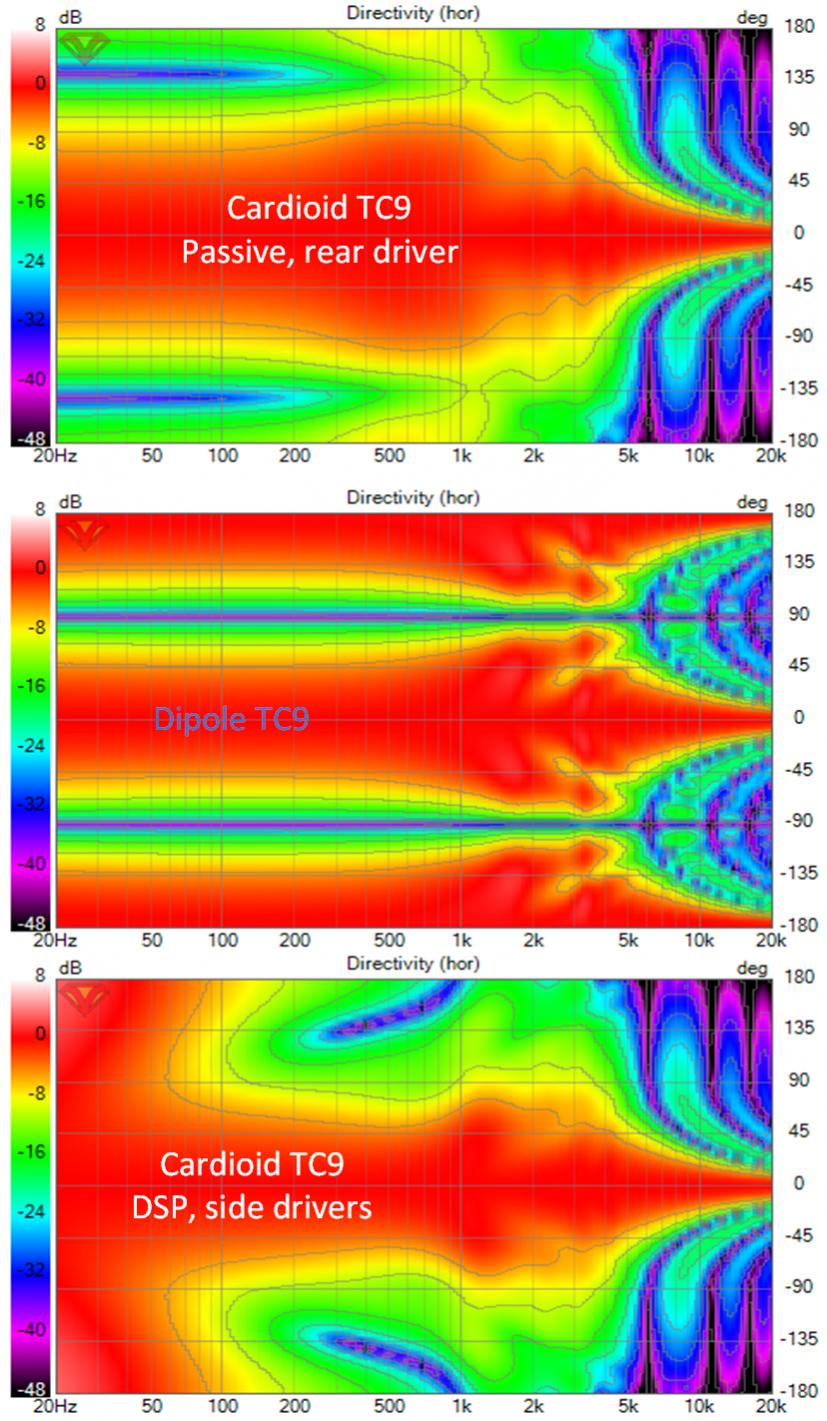
OB gives hard but narrow null out to the sides but obviously has equal rear radiation, which is put to good use in large enough space. Cardioid reduces output to the sides and rear allowing closer placement to walls and corner. The expectation is ambience drivers will provide the desired delayed reflections.
This modelling was done with TC9s. Here is the schematic
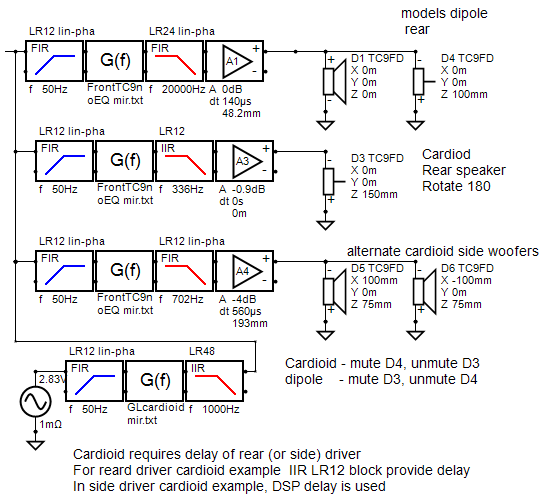
Anyone tempted to do a cardioid line array? Using the side or rear drivers to augment front below 100 Hz as in my 3D Cardioid Top, you wouldn't need subs.
Here is comparison of OB and cardioid.
OB gives hard but narrow null out to the sides but obviously has equal rear radiation, which is put to good use in large enough space. Cardioid reduces output to the sides and rear allowing closer placement to walls and corner. The expectation is ambience drivers will provide the desired delayed reflections.
This modelling was done with TC9s. Here is the schematic
Anyone tempted to do a cardioid line array? Using the side or rear drivers to augment front below 100 Hz as in my 3D Cardioid Top, you wouldn't need subs.
Attachments
Finally got around to doing a Vituix enclosure model for the front and side woofers in my 3D cardioid top. It took some time to balance contributions from front and side woofers below 100 Hz. Ultimately, I found I had to high pass at 60 Hz to limit excursion to Xmax at 105 db SPL. I was a little bit surprised at that but then I realized that with cardioid response, there won't be any boundary support. What remains surprising is that this seems to be true even below 100 Hz despite the design transitioning to monopole there.
I then asked myself what if I doubled the number of woofers to 8 front plus 8 sides? The added fronts were just above and below the existing fronts. The added sides were placed next to the existing sides; deeper Z, same X,Y. That extended LF to 43 hz or so and narrows the vertically incrementally below 500 Hz.
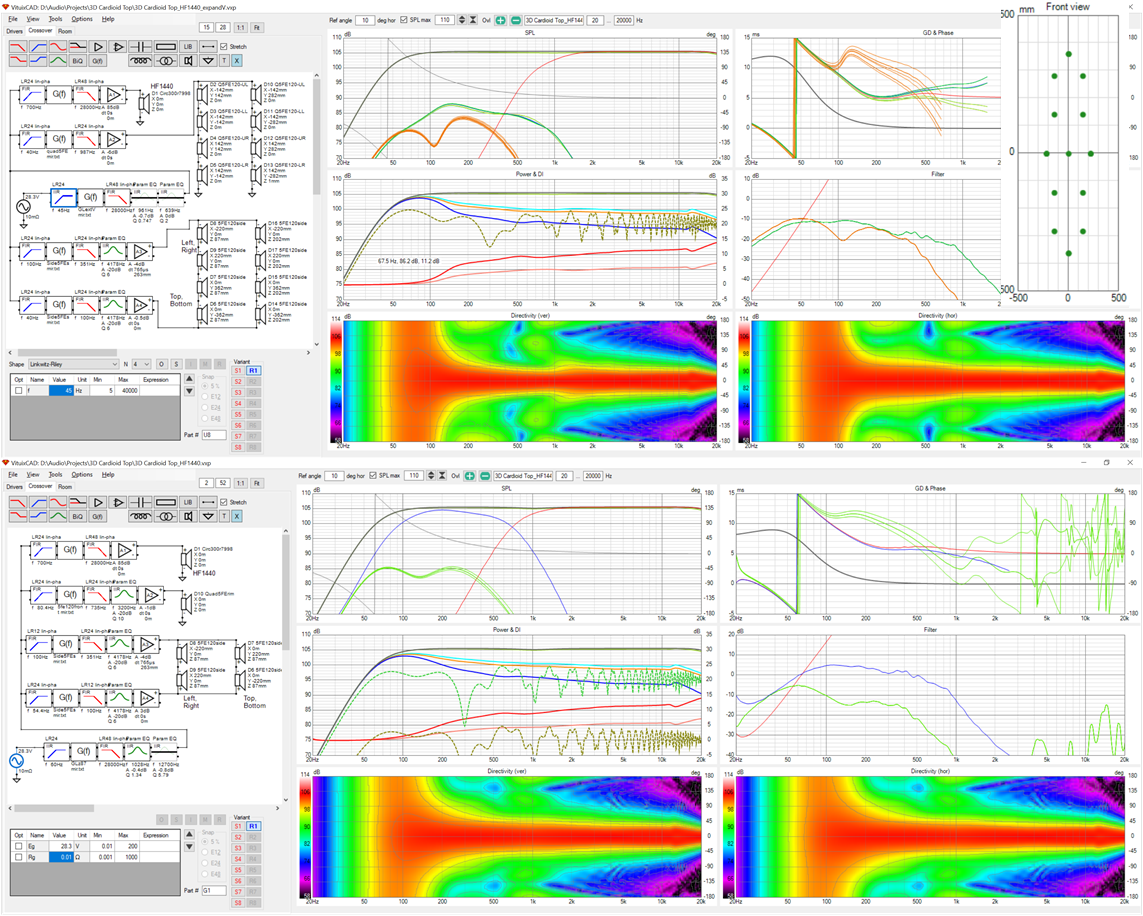
I still have the 300 Hz floor null, just as wide but not as deep, and I still need subwoofers assisting for a dynamic full range response so to me the extra expense, size, and cost don't seem warranted.
This exercise does point back to where we've been before. If we extend the two columns of midwoofers flanking the waveguide to floor and ceiling and augment them with side or rear woofers for cardioid response we then have perhaps the ultimate expression of a line array with waveguided tweeter at center.
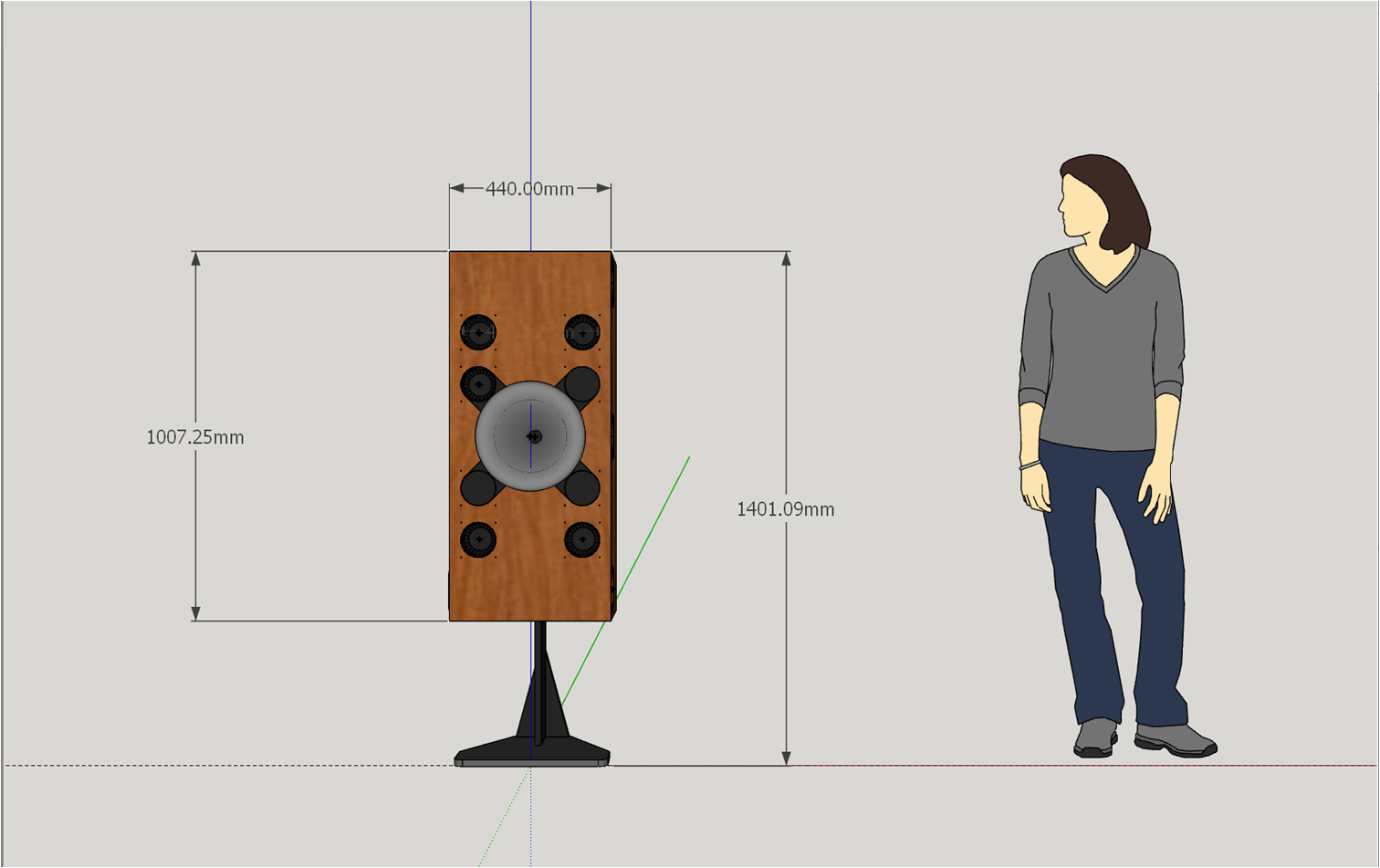
I then asked myself what if I doubled the number of woofers to 8 front plus 8 sides? The added fronts were just above and below the existing fronts. The added sides were placed next to the existing sides; deeper Z, same X,Y. That extended LF to 43 hz or so and narrows the vertically incrementally below 500 Hz.
I still have the 300 Hz floor null, just as wide but not as deep, and I still need subwoofers assisting for a dynamic full range response so to me the extra expense, size, and cost don't seem warranted.
This exercise does point back to where we've been before. If we extend the two columns of midwoofers flanking the waveguide to floor and ceiling and augment them with side or rear woofers for cardioid response we then have perhaps the ultimate expression of a line array with waveguided tweeter at center.
Attachments
Definitely tempted! My wife wants me to find someone to build them for me so I'm open to proposals. Ever since my quad bypass surgery 6 years ago, she tends to treat me as an invalid, or at least tries to keep me from overdoing it. I'm doing 8 miles or so most days on my inline speed skates (so rehab does work!) but she still cautions me to take it easy each time I step out the door.
Shrank the volume to make the 16 woofer array more manageable.
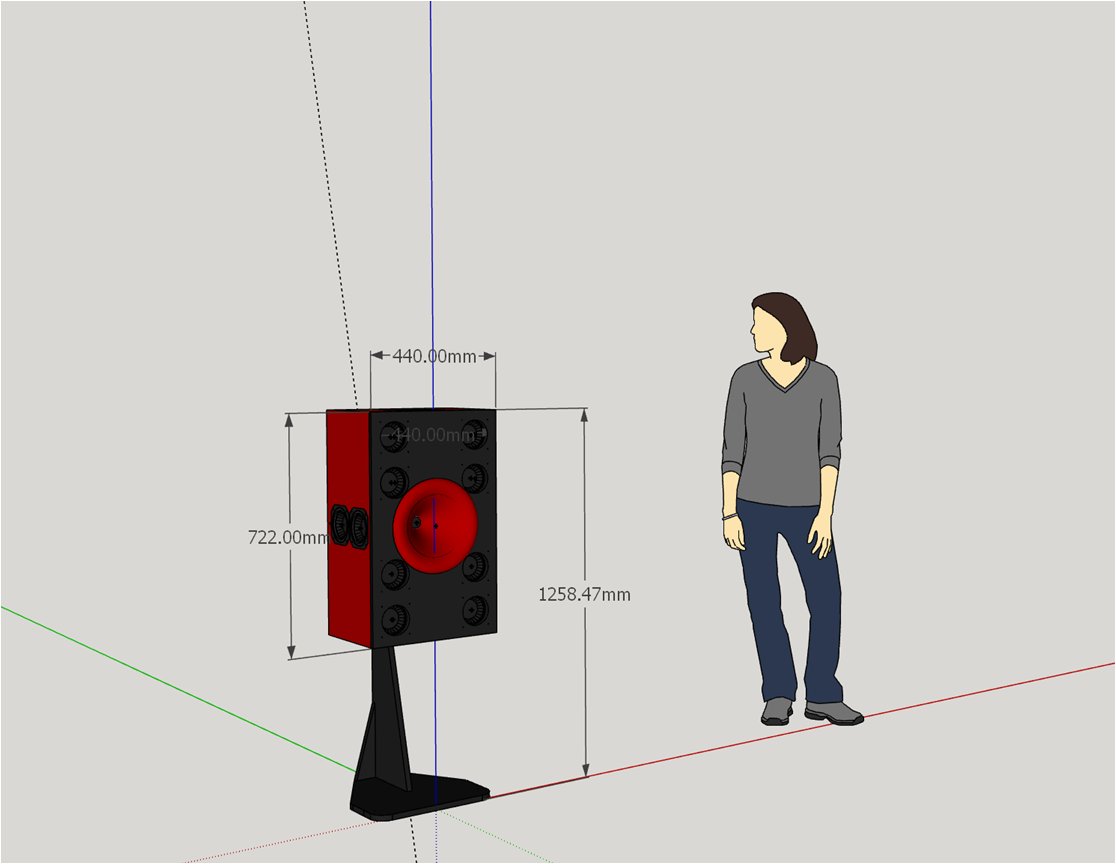
I like the higher directivity of the 16 woofer version below 500 Hz. Its pretty much immune to early wall reflections when toed in near a corner. Its going to weigh about 75 lbs. I wonder if that is too much to put up on a stand.
Shrank the volume to make the 16 woofer array more manageable.
I like the higher directivity of the 16 woofer version below 500 Hz. Its pretty much immune to early wall reflections when toed in near a corner. Its going to weigh about 75 lbs. I wonder if that is too much to put up on a stand.
Attachments
I doubt my girl can keep me out of the garage, as I love working with my hands. Even though I've given up on my other hobby that was fixing up/restoring cars.
She did issue a warning though: no more operating on the arrays, they are done (well almost).
It seems counter productive to give up the multi-woofer version to save weight. At one point they will just be there and don't move around that much.
75 lbs, got to translate that to kg, 34 kg, right? That isn't that much. Heck, my arrays weigh close to 75 Kg, maybe a bit more with the coils etc 😀.
You should be able to get a stand that can hold it, I'd say. It isn't a lightweight, but not that heavy either. Fabrication seems pretty straight forward, except
the custom horn... That could get expensive when you have to outsource it.
She did issue a warning though: no more operating on the arrays, they are done (well almost).
It seems counter productive to give up the multi-woofer version to save weight. At one point they will just be there and don't move around that much.
75 lbs, got to translate that to kg, 34 kg, right? That isn't that much. Heck, my arrays weigh close to 75 Kg, maybe a bit more with the coils etc 😀.
You should be able to get a stand that can hold it, I'd say. It isn't a lightweight, but not that heavy either. Fabrication seems pretty straight forward, except
the custom horn... That could get expensive when you have to outsource it.
Last edited:
Probably not as expensive as buying the tool to make it though 😉That could get expensive when you have to outsource it.
fluid should know. more expensive than the tool is the shop to keep it in and the time to learn how to use it, times 1 for CNC, which I have already learned up to creating tool paths, and times 2 for 3D printing.
I've gotten quotes on the waveguide from commercial 3D print shops at $450 ea. for raw fused deposition (DIY type) print to more than twice that for selective laser sintered parts that are more finished. Need to investigate more but that $450 quote isn't out of the question if its possible for me to do the finishing by hand.
I've gotten quotes on the waveguide from commercial 3D print shops at $450 ea. for raw fused deposition (DIY type) print to more than twice that for selective laser sintered parts that are more finished. Need to investigate more but that $450 quote isn't out of the question if its possible for me to do the finishing by hand.
We have discussed the effect of floor bounce (or lack thereof) in this thread a couple of times. Quite recently there's been an active thread over on ASR about disappearing speakers where Mr. Toole himself elaborated on that specific subject. See: What makes speakers "disappear " and can it be measured? | Page 7 | Audio Science Review (ASR) Forum
He specifically mentions that having no floor bounce "will sound" unnatural. It makes me wonder why no one complains about head phones and unnatural sound 😕.
His preference for classic music, and the lack of floor bounce in such recordings comes up in the discussion later on.
Just a heads up...
He specifically mentions that having no floor bounce "will sound" unnatural. It makes me wonder why no one complains about head phones and unnatural sound 😕.
His preference for classic music, and the lack of floor bounce in such recordings comes up in the discussion later on.
Just a heads up...
I've gotten quotes on the waveguide from commercial 3D print shops at $450 ea. for raw fused deposition (DIY type) print to more than twice that for selective laser sintered parts that are more finished. Need to investigate more but that $450 quote isn't out of the question if its possible for me to do the finishing by hand.
You've probably seen this post: https://www.diyaudio.com/forums/multi-way/338806-acoustic-horn-design-easy-ath4-761.html#post6741340 which does show a way to finish the DIY type of prints 😉.
I can't imagine more fundamental question than those posed in that thread.
As to floor reflection, I still have some - its about an 8 db dip for the 16 woofer version; more for the 8 woofer version. The reason I went this way is the referenced section from Toole on floor reflection. OTOH, I didn't find my line arrays to have an unnatural sound due to the absence of a floor reflection.
More challenging is the discussion on lateral reflections.
"In stereo listening, all of the variables in this test were influential, but the nature of the recordings themselves proved to be the overriding factor. The essential ingredients of “imaging” are in the recordings. Early lateral room
reflections, to the extent to which they were manipulated by loudspeaker directivity, seemed either be neutral-to beneficial factors in pop/rock style recordings and in monophonic listening. In classical recordings with substantial uncorrelated le-right information, the effects are not clear." (Toole 4.7.2)
My 60 degree beam width was chosen to limit floor reflection. Since the waveguide is axisymmetric, it also limits lateral reflections. I used to believe that early lateral reflections were bad and late reflections (from any direction) were good. Recent research/discussion indicates that at least some early reflections are good - but early is never quantified. My belief is that in a very small room, the reflections from a speaker within .5m of walls will be detrimentally early. In a room large enough to place the speakers >1m from boundaries, that would not be the case, consistent with conventional placement guidelines.
While there is a large camp that supports wide dispersion speakers, there is also one that supports 60 degree controlled directivity. That camp includes Tom Danley and his immanent Hyperion's.
What we are trying to do is make up for the lack of lateral reflections with ambient drivers; me because my directivity largely eliminates those from near walls, you because you've absorbed them. I think Toole wouldn't disagree with us but in his own work he has skipped over this step and gone to multi-channel audio, which in a sense is an extreme form of ambient drivers.
Toole from the ASR thread
"I too use Auro3D upmixing for almost all of my stereo program listening. It can be adjusted to add what is for me the right amount of very subtle envelopment - the perceptual element that stereo (a directionally and spatially deprived format) is most lacking."
As to floor reflection, I still have some - its about an 8 db dip for the 16 woofer version; more for the 8 woofer version. The reason I went this way is the referenced section from Toole on floor reflection. OTOH, I didn't find my line arrays to have an unnatural sound due to the absence of a floor reflection.
More challenging is the discussion on lateral reflections.
"In stereo listening, all of the variables in this test were influential, but the nature of the recordings themselves proved to be the overriding factor. The essential ingredients of “imaging” are in the recordings. Early lateral room
reflections, to the extent to which they were manipulated by loudspeaker directivity, seemed either be neutral-to beneficial factors in pop/rock style recordings and in monophonic listening. In classical recordings with substantial uncorrelated le-right information, the effects are not clear." (Toole 4.7.2)
My 60 degree beam width was chosen to limit floor reflection. Since the waveguide is axisymmetric, it also limits lateral reflections. I used to believe that early lateral reflections were bad and late reflections (from any direction) were good. Recent research/discussion indicates that at least some early reflections are good - but early is never quantified. My belief is that in a very small room, the reflections from a speaker within .5m of walls will be detrimentally early. In a room large enough to place the speakers >1m from boundaries, that would not be the case, consistent with conventional placement guidelines.
While there is a large camp that supports wide dispersion speakers, there is also one that supports 60 degree controlled directivity. That camp includes Tom Danley and his immanent Hyperion's.
What we are trying to do is make up for the lack of lateral reflections with ambient drivers; me because my directivity largely eliminates those from near walls, you because you've absorbed them. I think Toole wouldn't disagree with us but in his own work he has skipped over this step and gone to multi-channel audio, which in a sense is an extreme form of ambient drivers.
Toole from the ASR thread
"I too use Auro3D upmixing for almost all of my stereo program listening. It can be adjusted to add what is for me the right amount of very subtle envelopment - the perceptual element that stereo (a directionally and spatially deprived format) is most lacking."
reading further I found Toole responding to a question re' boundary interference. Summarizing, he sees it as a problem that can be addressed by equalizing the sound power, which is approximated by equalizing to average of multiple locations. Unfortunately, he doesn't consider using a cardioid response in the 100 to 500 Hz range to eliminate reduce SBIR. That is what I'm attempting here and I'm gratified that he sees boundary interference as something worth addressing. (unlike floor reflection)
Toole points out in his book that even if you eliminate the boundary interference by whatever means, you will still be subject to standing waves.
Toole points out in his book that even if you eliminate the boundary interference by whatever means, you will still be subject to standing waves.
You've probably seen this post: https://www.diyaudio.com/forums/multi-way/338806-acoustic-horn-design-easy-ath4-761.html#post6741340 which does show a way to finish the DIY type of prints 😉.
following that quite closely hoping it will eventually point the way to implementing the requisite waveguide.
at the same time, I'm investigating what it takes to mill the waveguide out of block or wood or stackup of plywood. My VCarvePro software can do the former and give an estimate on CNC milling time - which unoptimized was 50 hours for just one side because its a brute force milling algorithm.
If one were to slice the design in 18mm thick sections and mill each section separately, that time could be reduced drastically. One would only need to 3D mill the surface corresponding to the inside of the horn. The back side would be stepped. You would inside circle cut out, outside circle cut out and then 3D mill that 18mm high surface on the inside between top and bottom surfaces of the slice. It would still take a long time, not sure how long. I wonder if @JosephCrowe would care to comment and perhaps $benchmark quote. I wouldn't be surprised if fluid has thought about this.
Ultimately, I think breaking the design into smaller pieces printed separately will prove most cost effective. Commercial 3D printing costs increase with size of machine required. With smaller pieces, they can do the finishing by machine as well.
The ASR thread, Toole state the importance that the far off axis response, which gives rise to lateral reflections resemble the on-axis response in order for the reflections to be beneficial. Here are the simulations of my far off axis responses:
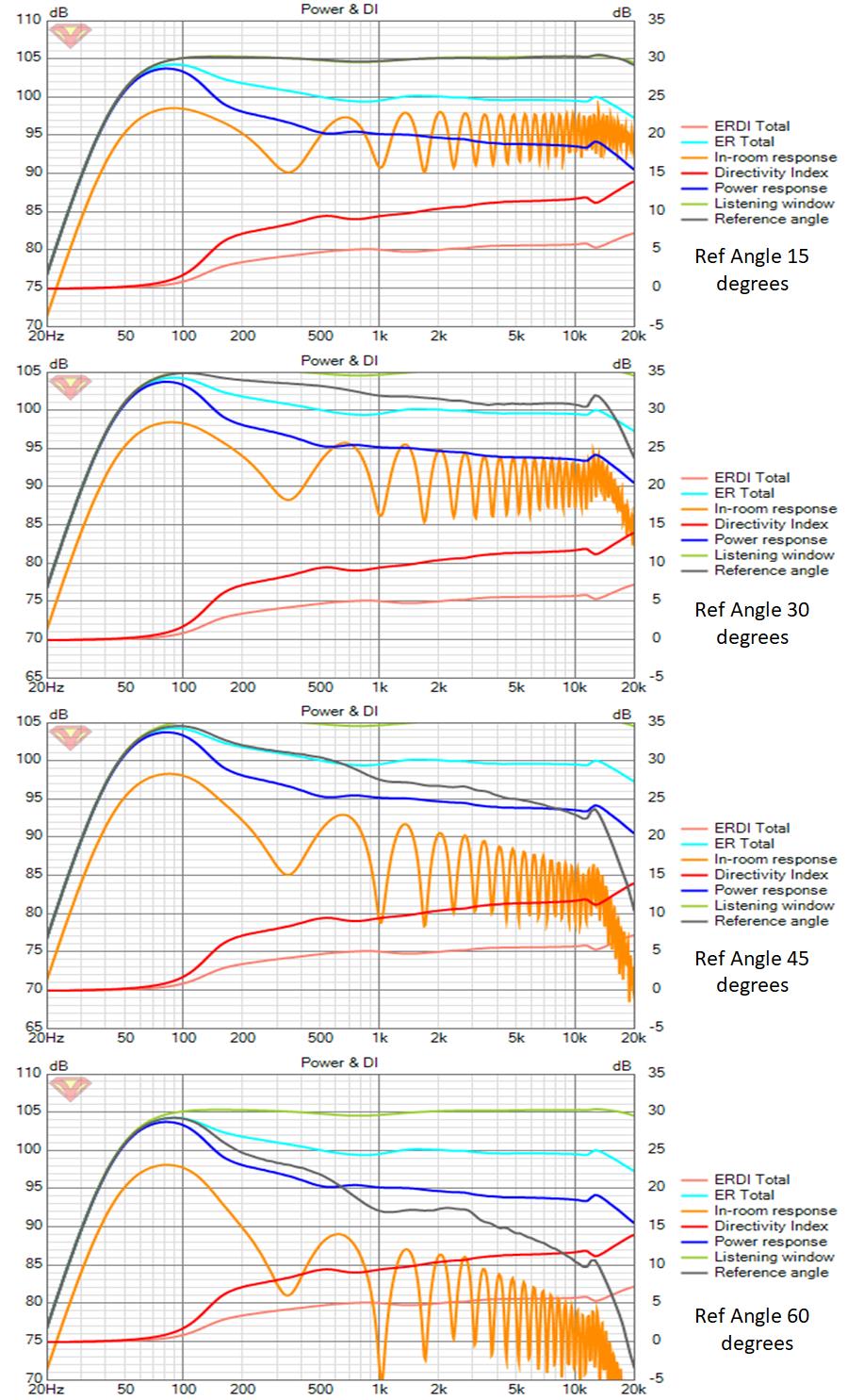
I show power and ref angle responses at 15,30,45 and 60 degrees. EQ was done at 10 degrees. At 30 degrees, the fringe of the beam, response is down a few degrees. There is progressive loss of treble the further off axis one goes. However, the power response does not show this because there isn't much power above 300 Hz more than 30 degrees off axis because of the directivity.
The in-room responses include only the floor reflection.
I show power and ref angle responses at 15,30,45 and 60 degrees. EQ was done at 10 degrees. At 30 degrees, the fringe of the beam, response is down a few degrees. There is progressive loss of treble the further off axis one goes. However, the power response does not show this because there isn't much power above 300 Hz more than 30 degrees off axis because of the directivity.
The in-room responses include only the floor reflection.
Attachments
- Home
- Loudspeakers
- Full Range
- Full range line array for wall or corner placement
